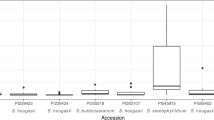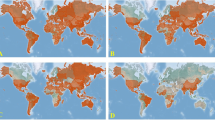Abstract
Host resistance to three major species of root-knot nematodes, Meloidogyne incognita, M. javanica and M. arenaria, has been introgressed in the cultivated tomato (Lycopersicon esculentum Mill.) from its wild relative L. peruvianum. The trait is dominant and has been located at a single locus, Mi-1, on chromosome 6. The Mi-1-conferred resistance is associated with a hypersensitive response in nematode-infected tissues; it is not efficient at soil temperature higher than 28 °C, and can be overcome by some “virulent” pathotypes as well as by the species M. hapla. Novel resistances, that have broader specificity to root-knot nematodes and are heat-stable, are pursued and identified in the wild tomato germplasm.
Molecular cloning of the Mi-1 locus, based on its map position, has been undertaken and reaches its final step. Some major obstacles due to the proximity of the Mi-1 locus to the centromere had to be overcome following the positional cloning approach, namely the presence of repetitive sequences and the suppression of recombination around Mi-1. Narrowing down the Mi-1 locus to less than 50 kb made complementation analysis possible. Transformation of susceptible tomato genotype with genomic and cDNA clones from the 50 kb region will reveal the sequence of Mi-1.
Access this chapter
Tax calculation will be finalised at checkout
Purchases are for personal use only
Preview
Unable to display preview. Download preview PDF.
Similar content being viewed by others
References
Aarts, J.M.M.J.G., Hontelez, J.G.J., Fischer, P., Verkerk, R., van Kammen, A., and Zabel, P. (1991) Acid phosphatase-11, a tightly linked molecular marker for root-knot nematode resistance in tomato: from protein to gene, using PCR and degenerate primers containing deoxyinosine, Plant Mol. Biol. 16, 647–661.
Ammati, M., Thomason, I.J., and McKinney, H.E. (1986) Retention of resistance to Meloidogyne incognita in Lycopersion genotypes at high soil temperature, J. Nematol. 18, 491–495.
Ammati, M., Thomason, I.J., and Roberts, P.A. (1985) Screening Lycopersion spp. for new genes imparting resistance to root-knot nematodes (Meloidogyne spp.), Plant Dis. 69, 112–115.
Bailey, D.M. (1941) The seedling test method for root-knot nematode resistance, Proc. Am. Soc. Hortic. Sci. 38, 573–575.
Barham, W.S., and Winstead, N.N. (1957) Inheritance of resistance to root-knot nematodes, Tomato Genet. Coop. Rep. 7, 3.
Briggs, S.P., and Johal, G.S. (1994) Genetic pattern of plant host-parasite interactions, Trends Genet. 10, 12–16.
Cap, G.B., Roberts, P.A., Thomason, I.J., and Murashige, T. (1991) Embryo culture of Lycopersicon esculentum x L. peruvianum hybrid genotypes possessing heat-stable resistance to Meloidogyne incognita, J.Amer Soc.Hort.Sci. 116, 1082–1088.
Cap, G.B., Roberts, P.A. and Thomason, I.J. (1993) Inheritance of heat-stable resistance to Meloidogyne incognita in L. peruvianum and its relationship to the Mi gene, Theor. Appl.. Genet 85, 777–783.
Castagnone-Sereno, P., Bongiovanni, M., Palloix, A., and Dalmasso, A. (1996) Selection for Meloidogyne incognita virulence against resistance genes from tomato and pepper and specificity of the virulence/resistance determinants, European J. Plant Pathology, in press.
Cook, R. (1991) Resistance in plants to cyst and root-knot nematodes, Agricult. Zool. Rev. 4, 213–240.
Dean, J.L., and Struble, F.B. (1953) Resistance and susceptibility to root-knot nematodes in tomato and sweet potato, Phytopathology 43, 290.
Dropkin, V.H. (1969) The necrotic reaction of tomatoes and other hosts resistant to Meloidogyne: reversal by temperature, Phytopathology 59, 1632–1637.
Fassuliotis, G. (1987) Genetic basis of plant resistance to nematodes, in Veech, J.A. and Dickson, D.W.(eds.), Vistas on nematology:, Soc. of Nematologists, Inc. Hyattsville, Maryland, pp.364–371.
Flor, H.H. (1956) The complementary genetic systems in flax and flax rust, Advan. Genet. 8, 29–54.
Frazier, W.A., and Dennett, R.K. (1949) Isolation of Lycopersicon esclentum type tomato lines essentially homozygous resistant to root-knot, Proc. Am. Soc. Hortic. Sci. 5, 225–236.
Ganal, M.W, and Tanksley, S.D. (1996) Recombination around the Tm2a and Mi resistance genes in different crosses of Lycopersicon peruvianum, Theor. Appl. Genet. 92, 101–108.
Gillbert, J.C. (1958) Some linkage studies with the Mi gene for resistance to root-knot, Tomato Genet. Coop. Rep. 8, 15–17.
Gillbert, J.C., and McGuire, D.C. (1956) Inheritance of resistance to several root-knot from Meloidogyne incognita in commercial type tomatos, Proc. Am. Soc. Hortic. Sci 68, 437–442.
Ho, J.Y., Weide, R., van Wordragen, M., Lambert, K., Koornneef, M., Zabel, P., Williamson, V.M. (1992) The root-knot nematode resistance gene (Mi) in tomato: construction of a molecular linkage map and identification of dominant cDNA markers in resistant genotypes, Plant J. 2, 971–982.
Holzman, O.V. (1965) Effect of soil temperature on resistance of tomato to root-knot nematode (Meloidogyne incognita), Phytopathology 55, 990–992.
Janssen, R., Bakker, J., and Gommers, F. (1991) Mendelian proof for a gene-for-gene relationship between virulence of Globodera rostochiensis and the H1 resistance gene in Solanum tuberosum spp. andigena CPC 1673, Revue Nematol. 14, 213–219.
Klein-Lankhorst, R,. Rietveld, P., Machiels, B., Verkerk, R., Weide, R., Gebhardt, C., Koornneef, M., and Zabel, P. (1991) RFLP markers linked to the root-knot nematode resistance gene Mi in tomato, Theor. Appl. Genet. 81, 661–667.
Liharska, T.B., Koornneef, M., van Wordragen, M., van Kammen, A., and Zabel, P. (1996) Tomato chromosome 6: effect of alien chromosomal segments on recombinant frequencies, Genome 39, in press.
Lobo, M., Navarro, R., and Munera, G. (1988) Meloidogyne incognita and Meloidogyne javanica resistance in Lycopersicon species, Tomato Genet. Coop. Rep. 38, 31–32.
Martin, G.B., Ganal, M.W., and Tanksley, S.D. (1992) Construction of yeast artificial chromosome library of tomato and identification of cloned segments linked to two disease resistance loci, Mol. Gen. Genet. 233, 25–32.
Medina-Filho, H., and Tanksley, S.D. (1983) Breeding for nematode resistance. In: Evans DA, Sharp WR, Ammirato PV, Yamada Y (Eds) Handbook of plant cell culture, Vol 1, Techniques for propagation and breeding, Mac Millan, New York, pp. 904–923.
Messenguer, R., Ganal, M., de Vicente, M.C., Young, N.D., Bolkan, H., and Tanksley, S.D. (1991) High resolution RFLP map around the root-knot nematode resistance gene (Mi) in tomato, Theor. Appl. Genet. 82, 529–536.
Paulson, R.E., and Webster, J.M. (1972) Ultrastructure of the hypersensitive reaction in roots of tomato, Lycopersicon esculentum L., to infection by root-knot nematode, Meloidogyne incognita, Physiol. Plant Pathol. 2, 227–234.
Rick, CM., and Fobes, J.F. (1974) Association of an allozyme with nematode resistance, Tomato Genet. Coop. Rep. 24: 25.
Roberts, P.A., Dalmasso, A., Cap, G.B., and Castagnone-Sereno, P. (1990) Resistance in Lycopersicon peruvianum to isolates of Mi gene-compatible Meloidogyne populations, J.Nematol. 22, 585–589.
Romshe, F.A. (1942) Nematode resistance test of tomato, Proc. Am. Soc. Hortic. Sci. 40, 423.
Sasser, J.N., Hartman, K.M., Carter, C.E. (1987) Summary of preliminary crop germplasm evaluation for resistance to root-knot nematodes, NC State University/US Agency Int. Dev. Raleigh NC, pp. 88.
Scott, J.W., Emmons, C.L., Overman, A.J., and Somodi, G.C. (1991) Introgression and genetics of heat stable nematode resistance from Lycopersicon peruvianum, Tomato Genet. Coop. Rep. 41, 46.
Sidhu, G.S., and Webster, J.M. (1981) The genetics of plant-nematode parasitic systems, Bot. Rev. 47, 387–419.
Smith, P.G. (1944) Embryo culture of a tomato species hybrid, Proc. Am.Soc.Hortic. Sci. 44, 413–416.
Staskawicz, B.J., Ausubel, F.A., Baker, B.J., Ellis, J.G., and Jones, J.D.G. (1995) Molecular genetics of plant disease resistance, Science 268, 661–667.
Tanksley, S.D., Ganal, M.W., and Martin, G.B. (1995) Chromosome landing: a paradigm for map-based gene cloning in plants with large genomes, Trends Genet. 11, 63–68.
Tanksley, S.D., Ganal, M.W., Prince, J.P., de Vincente, M.C., Bonierbale, M.W., Broun, P., Fulton, T.M., Giovanonni, J.J., Grandillo, S., Martin, G.B., Messeguer, R., Miller, J.C., Miller, L., Paterson, A.H., Pineda, O., Roder, M.S., Wing, R.A., Wu, W., Young, N.D. (1992) High density molecular linkage maps of the tomato and potato genomes, Genetics 132, 1141–1160.
Van Daelen, R. (1995) Towards isolation of the tomato root-knot nematode resistance gene Mi via positional cloning, PhD thesis, Wageningen Agricultural University.
Van Daelen, R.A.J.J., Grebens, F., van Ruissen, F., Aarts, J., Hontelez, J., and Zabel, P. (1993) Long-range physical maps of two loci (Aps-1 and GP79) flanking the root-knot nematode resistance gene (Mi) near the of tomato chromosome 6, Plant. Mol. Biol. 23, 185–192.
Van Wordragen, M.F., Weide, R., Liharska, T.B., van der Steen, A., Koornneef, M., and Zabel, P. (1994) Genetic and molecular organisation of the short arm and pericentromeric region of tomato chromosome 6, Euphytica 79, 169–174.
Veremis, J.C., and Roberts, P.A. (1996a) Differentiation of Meloidogyne incognita and M. arenaria novel resistance phenotypes in Lycopersiconperuvianum and derived bridge lines, Theor. Appl. Genet., in press.
Veremis, J.C., and Roberts, P.A.(1996b) Relationships between Meloidogyne incognita resistance genes in Lycopersicon peruvianum differentiated by heat sensitivity and nematode virulence, Theor. Appl. Genet., in press.
Veremis, J.C., and Roberts, P.A.(1996c) Identification of resistance to Meloidogyne javanica in the Lycopersicon peruvianum complex, Theor. Appl. Genet., in press.
Weide, R., van Wordragen, M., Klein-Lankhorst, R., Verkerk, R., Hanhart, C., Liharska, T., Pap, E., Stam, P., Zabel, P., and Koornneef, M. (1993) Integration of the classical and molecular linkage maps of tomato chromosome 6, Genetics 135, 1175–1186.
Williamson V.M., and Colwell, G. (1991) Acid phosphatase-1 from nematode resistant tomato: isolation and characterization of the gene, Plant Physiol. 97, 139–146.
Williamson V.M., Ho, J.Y., Wu, F.F., Miller, N., and Kaloshian, I. (1994) A PCR-based marker tightly linked to the nematode resistance gene, Mi, in tomato, Theor. Appl. Genet. 87, 757–763.
Yaghoobi, J., Kaloshian, I., Wen, Y., and Williamson, V. M. (1995) Mapping a new nematode resistance locus in Lycopersicon peruvianum, Theor. Appl. Genet. 91, 457–446
Author information
Authors and Affiliations
Editor information
Editors and Affiliations
Rights and permissions
Copyright information
© 1997 Springer Science+Business Media Dordrecht
About this chapter
Cite this chapter
Liharska, T.B., Williamson, V.M. (1997). Resistance to Root-Knot Nematodes in Tomato. In: Fenoll, C., Grundler, F.M.W., Ohl, S.A. (eds) Cellular and Molecular Aspects of Plant-Nematode Interactions. Developments in Plant Pathology, vol 10. Springer, Dordrecht. https://doi.org/10.1007/978-94-011-5596-0_15
Download citation
DOI: https://doi.org/10.1007/978-94-011-5596-0_15
Publisher Name: Springer, Dordrecht
Print ISBN: 978-94-010-6360-9
Online ISBN: 978-94-011-5596-0
eBook Packages: Springer Book Archive




